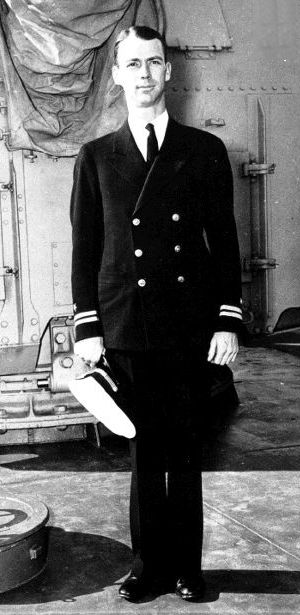

Source: Milt Hackett, USS Strong.
LCdr. Frederick W. Purdy.
On 10 June 1942 he reported to Bath, Maine as prospective executive officer of Strong the fourth 2,100-ton Fletcher-class destroyer (after Nicholas, O’Bannon and Chevalier) built at Bath Iron Works.
After commissioning, Strong sailed in support of the invasion of North Africa and then to the South Pacific where, in March 1943, she and her sisters from Bath were formed into Destroyer Division 41 of Destroyer Squadron 21.
In the early hours of 5 July 1943, Strong was operating with flagship Nicholas in the van of RAdm. W. L. “Pug” Ainsworth’s Task Force 18—light cruisers Honolulu, Helena and St. Louis—with Chevalier and O’Bannon in the rear. Their mission was to bombard Bairoko Harbor, New Georgia Island, in support of the Marine campaign to take Munda airfield.
With insufficient warning to evade, Strong was hit by a “Long Lance” torpedo, determined post-war to have been launched by one of three undetected enemy destroyers, an estimated 11 miles away.
It soon became apparent that Strong was sinking by the stern. Chevalier, approaching from the rear, deliberately rammed Strong forward to take off shipmates. In the confusion, O’Bannon glanced off Chevalier’s stern, then returned fire from shore batteries on nearby New Georgia Island, which had opened fire and quickly found Strong’s range.
Strong remained afloat for seven minutes. During this time, LCdr. Purdy and other officers helped as many crewmembers as possible jump from Strong’s forecastle to Chevalier. When Strong sank out from under them, these officers found themselves in the water. There followed a major explosion—possibly from depth charges or detonation of another torpedo warhead. Fortunately it did not kill all those remaining in the water, some of whom found a floater net to cling to.
In the water, torpedo officer Lt (j.g.) Milt Hackett believed that he and LCdr. Purdy were in close proximity until Hackett and Lt (j.g.) Fulham began swimming to Rice Anchorage on New George Island to get help from US forces there. When they had swum about 3/4 mile from the floater net, they observed a small Japanese landing craft approaching from Kolombangara to the west, which proceeded to shoot many of the survivors in the water. It has been conjectured that LCdr. Purdy was among the victims.
LCdr. Purdy’s body was later found by Robert F. Gregory, S1/c, part of a small group of survivors that reached Kolombangara. Gregory later turned Purdy’s wallet over to the Marines on New Georgia.
For his action that night, Lieutenant Commander Purdy was posthumously awarded the Silver Star Medal for “conspicuous gallantry and intrepidity . . .” The citation further noted that Purdy’s “heroic spirit of self-sacrifice and his inspiring conduct throughout a hazardous and critical period were in keeping with the highest traditions of the United States Naval Service. He gallantly gave his life for his country.”
Sources: Stories of USS Strong (DD 467) by Al Grimes courtesy Mrs. Frances Grimes; Dictionary of American Naval Fighting Ships, Naval History & Heritage Command; conversations between David McComb and Strong Torpedo Officer Milt Hackett, 2001–3.